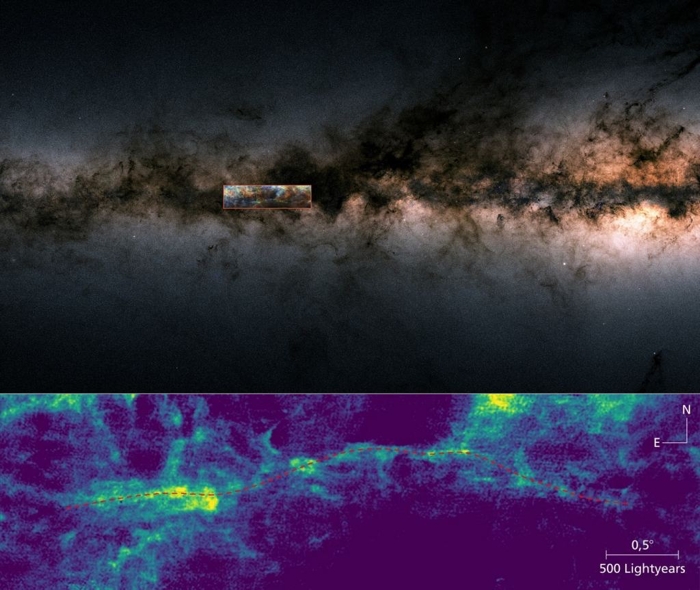About 370,000 years after the creation of the universe, hydrogen had formed, the building block of stars, which fuse hydrogen and helium in their interiors to create all the heavier elements. It is difficult to detect individual clouds of hydrogen gas in the interstellar medium (ISM).
An international team led by astronomers from the Max Planck Institute of Astronomy (MPIA) has observed a structure named ‘Maggie‘, which is a massive filament of atomic hydrogen gas in our galaxy. It is located about 55,000 light-years away (on the other side of the Milky Way) and is one of the longest structures ever observed in our galaxy.
The study was featured in the Astronomy & Astrophysics journal and was led by Jonas Syed, a Ph.D. student at the MPIA.
He was joined by researchers from the University of Vienna, the Harvard-Smithsonian Center for Astrophysics (CfA), the Max Planck Institute for Radio Astronomy (MPIFR), the University of Calgary, the Universität Heidelberg, the Centre for Astrophysics and Planetary Science, the Argelander-Institute for Astronomy, the Indian Institute of Science, and NASA’s Jet Propulsion Laboratory (JPL).
The research is based on data obtained by the HI/OH/Recombination line survey of the Milky Way (THOR), an observation program that relies on the Karl G. Jansky Very Large Array (VLA) in New Mexico.

The project studies molecular cloud formation, the conversion of atomic to molecular hydrogen, the galaxy’s magnetic field, and other questions related to the ISM and star formation.
The ultimate purpose is to determine how the two most-common hydrogen isotopes converge to create dense clouds that rise to new stars
Syed explains in a recent MPIA press release:
“The location of this filament has contributed to this success. We don’t yet know exactly how it got there. But the filament extends about 1600 light-years below the Milky Way plane. The observations also allowed us to determine the velocity of the hydrogen gas. This allowed us to show that the velocities along the filament barely differ.”
It was found that matter in the filament had a mean velocity of 54 km/s-1. This meant that radiation at a wavelength of 21 cm (aka the “hydrogen line”) was visible against the cosmic background.
“The observations also allowed us to determine the velocity of the hydrogen gas,” said Henrik Beuther, the head of THOR and a co-author of the study. “This allowed us to show that the velocities along the filament barely differ.”
It was named after the longest river in his native Colombia, the Río Magdalena (Anglicized: Margaret, or “Maggie”). It was also revealed that Maggie contains 8 percent molecular hydrogen by a mass fraction.
“However, many questions remain unanswered,” Syed added. “Additional data, which we hope will give us more clues about the fraction of molecular gas, are already waiting to be analyzed.”
Fortunately, several space-based and ground-based observatories will become operational soon like the James Webb Space Telescope and radio surveys like the Square Kilometer Array (SKA). They will allow us to study the origin of stars and galaxies.


